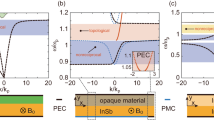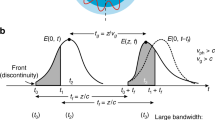Abstract
Invisibility is a notion that has long captivated the popular imagination. However, in 2006, invisibility became a practical matter for the scientific community as well, with the suggestion that artificially structured metamaterials could enable a new electromagnetic design paradigm, now termed transformation optics1. Since the advent of transformation optics and subsequent initial demonstration of the microwave cloak2, the field has grown rapidly. However, the complexity of the transformation optics material prescription has continually forced researchers to make simplifying approximations to achieve even a subset of the desired functionality3,4,5,6,7,8,9,10,11,12,13,14. These approximations place profound limitations on the performance of transformation optics devices in general11, and cloaks especially15,16. Here, we design and experimentally characterize a two-dimensional, unidirectional cloak that makes no approximations to the underlying transformation optics formulation, yet is capable of reducing the scattering of an object ten wavelengths in size. We demonstrate that this approximation-free design regains the performance characteristics promised by transformation optics.
This is a preview of subscription content, access via your institution
Access options
Subscribe to this journal
Receive 12 print issues and online access
$259.00 per year
only $21.58 per issue
Buy this article
- Purchase on Springer Link
- Instant access to full article PDF
Prices may be subject to local taxes which are calculated during checkout




Similar content being viewed by others
References
Pendry, J. B., Schurig, D. & Smith, D. R. Controlling electromagnetic fields. Science 312, 1780–1782 (2006).
Schurig, D. et al. Metamaterial electromagnetic cloak at microwave frequencies. Science 314, 977–980 (2006).
Cai, W. et al. Optical cloaking with metamaterials. Nature Photon. 1, 224–227 (2007).
Li, J. & Pendry, J. B. Hiding under the carpet: A new strategy for cloaking. Phys. Rev. Lett. 101, 203901 (2008).
Liu, R. et al. Broadband ground-plane cloak. Science 323, 366–369 (2009).
Smolyaninov, I. I., Smolyaninova, V. N., Kildishev, A. V. & Shalaev, V. M. Anisotropic metamaterials emulated by tapered waveguides: Application to optical cloaking. Phys. Rev. Lett. 102, 213901 (2009).
Ma, Y. G., Ong, C. K., Tyc, T. & Leonhardt, U. An omnidirectional retroreflector based on the transmutation of dielectric singularities. Nature Mater. 8, 639–642 (2009).
Kundtz, N. & Smith, D. R. Extreme-angle broadband metamaterial lens. Nature Mater. 9, 129–132 (2010).
Ma, H. & Cui, T. J. Three-dimensional broadband ground-plane cloak made of metamaterials. Nature Commun. 1, 124 (2010).
Ergin, T., Stenger, N., Brenner, P., Pendry, J. B. & Wegener, M. Three-dimensional invisibility cloak at optical wavelengths. Science 328, 337–339 (2010).
Landy, N. I., Kundtz, N. & Smith, D. R. Designing three-dimensional transformation optical media using quasiconformal coordinate transformations. Phys. Rev. Lett. 105, 193902 (2010).
Gömöry, F. et al. Experimental realization of a magnetic cloak. Science 335, 1466–1468 (2012).
Chen, X. et al. Macroscopic invisibility cloaking of visible light. Nature Commun. 2, 176 (2011).
Zhang, B., Luo, Y., Liu, X. & Barbastathis, G. Macroscopic invisibility cloak for visible light. Phys. Rev. Lett. 106, 033901 (2011).
Yan, M., Ruan, Z. & Qiu, M. Cylindrical invisibility cloak with simplified material parameters is inherently visible. Phys. Rev. Lett. 99, 233901 (2007).
Zhang, B., Chan, T. & Wu, B-I. Lateral shift makes a ground-plane cloak detectable. Phys. Rev. Lett. 104, 233903 (2010).
Luo, Y. et al. A rigorous analysis of plane-transformed invisibility cloaks. IEEE Trans. Antennas. Propag. 57, 3926–3933 (2009).
Xi, S., Chen, H., Wu, B-I. & Kong, J. A. One-directional perfect cloak created with homogeneous material. IEEE Microw. Wirel. Compon. Lett. 19, 131 (2009).
Popa, B-I., Zigoneanu, L. & Cummer, S. A. Experimental acoustic ground cloak in air. Phys. Rev. Lett. 106, 253901 (2011).
Pendry, J. B., Holden, A. J., Robbins, D. J. & Stewart, W. J. Magnetism from conductors and enhanced non-linear phenomena. IEEE Trans. Micr. Theory Techniques 47, 2075–2084 (2006).
Marqués, R., Medina, F. & Rafii-El-Idrissi, R. Role of bianisotropy in negative permeability and left-handed metamaterials. Phys. Rev. B 65, 144440 (2002).
Smith, D. R., Schultz, S., Markos, P. & Soukoulis, C. M. Determination of effective permittivity and permeability of metamaterials from reflection and transmission coefficients. Phys. Rev. B. 65, 195104 (2002).
Smith, D. R., Vier, D. C., Koschny, T. & Soukoulis, C. M. Electromagnetic parameter retrieval from inhomogeneous metamaterials. Phys. Rev. E 71, 036617 (2005).
Justice, B. J. et al. Spatial mapping of the internal and external electromagnetic fields of negative index metamaterials. Opt. Express 14, 8694–8705 (2006).
Acknowledgements
This work was financially supported by the Office of Naval Research through contract No. N00167-11-P-0292, administered by the Naval Surface Warfare Center. Partial support for this project also came from a Multidisciplinary University Research Initiative, sponsored by the US Army Research Office (Grant No. W911NF-09-1-0539). We also acknowledge insightful discussions with D. Rule, K. Boulais, L. Hale and R. Stark.
Author information
Authors and Affiliations
Contributions
N.L. and D.R.S. jointly conceived of the full-parameter implementation of the carpet cloak. N.L. conceived of the use of corrugations as anisotropic, permeable media. N.L. designed, fabricated and measured the cloak. The manuscript was prepared by N.L. under the supervision of D.R.S.
Corresponding author
Ethics declarations
Competing interests
The authors declare no competing financial interests.
Supplementary information
Supplementary Information
Supplementary Information (PDF 650 kb)
Supplementary Information
Supplementary Movie S1 (MOV 5769 kb)
Supplementary Information
Supplementary Movie S2 (MOV 4426 kb)
Rights and permissions
About this article
Cite this article
Landy, N., Smith, D. A full-parameter unidirectional metamaterial cloak for microwaves. Nature Mater 12, 25–28 (2013). https://doi.org/10.1038/nmat3476
Received:
Accepted:
Published:
Issue Date:
DOI: https://doi.org/10.1038/nmat3476
This article is cited by
-
Exploring localized ENZ resonances and their role in superscattering, wideband invisibility, and tunable scattering
Scientific Reports (2024)
-
Geometric multipole expansion and its application to semi-neutral inclusions of general shape
Zeitschrift für angewandte Mathematik und Physik (2023)
-
Ultrabroadband Nanostructured Metamaterial Absorber for Visible and Short-Infrared Spectrum
Plasmonics (2023)
-
Strictly conformal transformation optics for directivity enhancement and unidirectional cloaking of a cylindrical wire antenna
Scientific Reports (2022)
-
Phase control of pulses distortions through induced circular birefringent chiral atomic medium
Optical and Quantum Electronics (2022)



